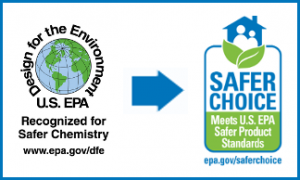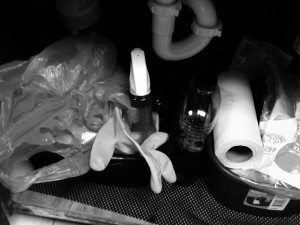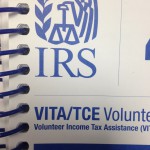by Heidi Copeland | Mar 24, 2015

On March 4, 2015 the EPA (Environmental Protection Agency) unveiled a new Safer Choice label/logo, which makes it easier to find household cleaners and other home products that are safer, more environmentally friendly—and still get the job done!
Finding cleaning and other products that are safer for you, your family, and the environment should be easy. Products with the Safer Choice label help consumers and commercial buyers identify and select products with safer chemical ingredients, without sacrificing quality or performance.
Safer Choice labels can be found on laundry products, all-purpose cleaners, car care products, dishwashing products, tub and tile products as well as floor care products. Some of these products will also carry a “Fragrance-free” notation.
The Safer Choice standard, formerly known as DfE’s – Standard for Safer Products (or the “DfE Standard”) identifies that the products and their ingredients met the Safer Choice label/logo requirement.
Safer Choice used the technical expertise of its workgroup (EPA scientists, formulators and even environmentalists to identify ingredients with the lowest hazard profile). While many of us take cleaning products for granted most are a highly scientific formula of ingredients, each with its distinct functional properties. Take dish washing liquid for example. Many of these products contain surfactants that aid in cleaning by reducing surface tension, solvents that dissolve or suspend materials, and chelating agents that reduce water hardness. Without the use of these ingredients we would probably complain about the effectiveness of the product.
A Safer Choice product contains the safest possible ingredients. Each ingredient has been screened for negative synergies (dangerous chemical combinations), potential human health effects, and environmental effects– based on the best available data. Safer Choice products will use ingredients with the lowest hazard in their functional class while still be high-performing.
Only products who have become Safer Choice partners can earn the right to display the Safer Choice product label/logo. Products using the Safer Choice label/logo have invested heavily in research, development and reformulation to ensure that their ingredients and finished product align at the green end of the health and environmental spectrum, while maintaining product performance.
Please note, the use of the Safer Choice label/logo does not constitute endorsement from the Environmental Protection Agency (EPA). It does however, recognize the company using the Safer Choice label/logo has gone through rigorous screening and uses ingredients with more positive human health and environmental characteristics than conventional products of the same type.
For more information see:
http://www2.epa.gov/saferchoice/safer-choice-standard
Heidi Copeland
Extension Agent II
Have a question? Contact the University of Florida IFAS – Leon County Extension office at 606-5203, weekdays 8 a.m. to noon or 1 to 5 p.m.
University of Florida IFAS – An Equal Opportunity Institution
by Heidi Copeland | Mar 24, 2015

Spring cleaning of one’s home is a tradition dating back centuries that is tied to the vernal equinox – the first day of spring. At the spring equinox, days are approximately 12 hours long with day length increasing as the season progresses. In many cultures this longer, lighter, warmer day is often a cause for celebration! And who could even think about celebrating a longer, lovelier day without a clean home?
The kitchen is a great place to start! You can protect yourself by preventing the spread of germs where food is prepared. However, the terms clean, sanitize and disinfect are often used interchangeably which can cause confusion. Best practices based upon current research state that cleaning and sanitizing is multi-step process. And even though surfaces look visibly clean, they may still be contaminated with microorganisms (infectious fungi, bacteria and viruses).
Cleaning is the removal of dirt from food preparation surfaces. These can be counters, cutting boards, dishes knives, utensils pots and pans – even your refrigerator.
- Wash surface with soap and warm water
- Rinse with clean water
- Air dry or dry with a clean disposable towel
Sanitizing reduces germs on inanimate – nonliving surfaces.
- Wash surface with soap and warm water using appropriate cleaning agents and equipment. Detergents can penetrate soil quickly whereas solvent, acid or abrasive cleaners may be needed for deep cleaning. The friction of cleaning — often with soap and water — removes most surface germs, which is adequate for most household surfaces.
- Rinse with clean water
- Air dry or dry with a clean disposable towel
Disinfecting destroys or inactivates most germs on inanimate surfaces.
- Wash surface with soap and warm water
- Rinse with clean water
- Disinfecting is not appropriate in all cases. However, it’s a good idea to get in the routine of disinfecting countertops, door and cabinet handles, and sink and sink faucets as these places are used frequently- think where dirt and guck can collect!
- Air dry or dry with a clean disposable towel
Also remember to disinfect dishcloths – often. Launder dishcloths frequently using the hot water cycle of the washing machine. Be sure to dry cloths thoroughly. These items can harbor bacteria and when wet, promote bacterial growth. Also, consider using disposable towels to clean up surfaces.
And don’t forget your kitchen sink drain and disposal. Once or twice a week clean, sanitize and disinfect.
Bathroom surfaces can be of critical concern. Surfaces closest to the toilet bowl – seat, cistern and nearby walls and shelving are most affected. When cleaning and disinfecting bathroom surfaces it is important to understand fecal matter is especially a huge matter of concern!
Then there are our general housekeeping surfaces, floors, walls, and furniture, which are low–touch surfaces that require low-level of disinfections. Cleaning these surfaces frequently with a bit of detergent or a low-level disinfectant designed for general housekeeping can decrease the level of contamination. General procedures should be followed. Remove dirt form surfaces (dust, vacuum or sweep) sanitize or disinfect, allow surfaces to air dry.
Thorough cleaning of all surfaces is important to reduce the spread of pathogens. High-touch surfaces, surfaces that are handled frequently, throughout the day, by numerous people, need cleaning and disinfecting. These surfaces can include doorknobs, light switches, phones, keyboards etc. that can become contaminated by objects such an inadequately cleaned rag, sponges or even improperly washed hands.
Cleaning regularly prevents the build-up of materials that can carry pathogens and support their growth. Some pathogens, viruses especially, can have a long shelf life and can stay on surfaces if they are not properly cleaned, sanitized or disinfected.
Take a look at The University of Florida IFAS EDIS publication explaining the use of common household products to use effectively as sanitizers. Also remember, it is critical to read and follow the safety instructions on any product you use.
http://edis.ifas.ufl.edu/pdffiles/FY/FY128000.pdf
http://www2.epa.gov/saferchoice
Heidi Copeland Extension Agent II Family and Consumer Sciences
615 Paul Russell Road Tallahassee, FL 32301-7060 850/606-5203
by Heidi Copeland | Jan 30, 2015
 In the early ’70s, Gary Iskowitz was doing graduate work as well as teaching tax law while working for the Internal Revenue Service (IRS). Mr. Iskowitz saw a growing problem with questionable tax preparers who were scamming low-income people in his area. He did not like what he saw! Consequently, he proposed training a few like-minded student volunteers to go into the community to prepare free tax returns for under-served residents.
In the early ’70s, Gary Iskowitz was doing graduate work as well as teaching tax law while working for the Internal Revenue Service (IRS). Mr. Iskowitz saw a growing problem with questionable tax preparers who were scamming low-income people in his area. He did not like what he saw! Consequently, he proposed training a few like-minded student volunteers to go into the community to prepare free tax returns for under-served residents.
The rest, they say, is history! Starting with this volunteer effort, 40 years later, the Volunteer Income Tax Assistance (VITA) Program is still going strong.
VITA still is designed to promote and support free tax preparation service for the under-served in both urban and non-urban locations. Service is targeted to low-to moderate- income individuals, persons with disabilities, the elderly, and limited English-speaking individuals.
Why? Just as in Gary Iskowitz’ time, this program is an effort to provide both a valuable community service and a powerful learning experience for the participants. Not only does a tax payer get their taxes done for free, the local community benefits from the monies spent by the tax payer. Plus, the IRS is pleased because citizens are in compliance with federal law.
Check out your local VITA sites this year. Around North Florida, there are numerous volunteer sites being readied for the 2014 tax year. Some of these sites are traditional, where taxes are done in person; some sites prepare taxes via SKYPE – the telecommunications application software that specializes in providing video chat and voice calls from computers. Using SKYPE as an application to accessing VITA has been well received, especially in rural locations.
If you plan to take advantage of any of the VITA programs this year, be sure to bring the proper documentation. A return cannot be prepared without the appropriate documentation. For a complete list of documentation needed for a VITA-prepared tax return, contact your local VITA tax preparation site. Where are these sites? Call your local helpline 2-1-1 or visit http://irs.treasury.gov/freetaxprep/.
by Heidi Copeland | May 12, 2014
 Not much has changed since the American Academy of Pediatrics released their clinical report in 2006 about the importance of play in promoting healthy child development. In fact, play is so important to optimal child development that in 1989 the United Nations High Commission for Human Rights recognized play as a right of every child. Seriously! Play is essential to child development. Play contributes to the cognitive, physical, social, and emotional well-being of children and youth.
Not much has changed since the American Academy of Pediatrics released their clinical report in 2006 about the importance of play in promoting healthy child development. In fact, play is so important to optimal child development that in 1989 the United Nations High Commission for Human Rights recognized play as a right of every child. Seriously! Play is essential to child development. Play contributes to the cognitive, physical, social, and emotional well-being of children and youth.
Play is a child’s work. Play is how a child learns best. Play is the most effective way to involve every aspect of child development – cognitive, physical, social, and emotional well-being of children and youth. Play allows children to engage and interact in the world around them. Play enhances children’s learning readiness, learning behaviors, and problem-solving skills. Play is a simple joy that we should all remember as a cherished part of childhood.
Nonetheless, children and youth are experiencing decreased amount of child-directed, free unstructured play.
As another school year comes to an ends start thinking about the importance of this free, unstructured, child-driven play this summer. Are you allowing enough time in each day for your child to be running, bike riding, bouncing balls, climbing, and gazing up at the clouds actively using their imagination? Or are they going to be sitting and passively entertained through the screens of a television, computer, video game or even phone?
Think about it, play is a tried-and-true part of child rearing. Play also offers a perfect opportunity for parents to get fully involved with their children and youth.
Don’t buy into the next thingamajig that promises to make your child, better, brighter, happier, or more successful. Buy into the tried, trusted and traditional methods of play! The only thing you have to invest is quality time with your children and youth.
As the clinical report also mentions, adults who share unscheduled, spontaneous playtime with their children are being wonderfully supportive, nurturing and productive. What do you have to lose? Make some time to play today!
by Heidi Copeland | May 12, 2014
 The President of the United States of America, Barack Obama has proclaimed obesity a national, serious public health issue. As such, he is encouraging all Americans to learn about and engage in activities that promote healthy eating.
The President of the United States of America, Barack Obama has proclaimed obesity a national, serious public health issue. As such, he is encouraging all Americans to learn about and engage in activities that promote healthy eating.
How can you get involved? Let’s start with the family meal. There are many benefits to family meals. Families are more likely to eat a nutritious meal when most or all of the family eats together. Plus, families who eat at home have control of portion sizes and ingredient choices. Additionally, children who eat with their families are likely to consume more fruits, vegetables, and whole grains and less fat sugar and empty calories.
Research shows that adolescents are also less likely to smoke, drink, and use illegal drugs during their teen years. Enjoying family meals together enhances family communication and provides opportunities for families to share traditions, recipes and family heritage that can be handed down through each generation. And, family meals improve manners, too!
We are not talking about a Thanksgiving type spread here. A family meal can be breakfast, lunch or dinner. Nutrition experts state the meal does not even have to be enjoyed around the table. The important fact is that it is enjoyed together creating a lifetime of positive memories.
Cooking at home can be an intimidating task, but a rewarding one for you, your family, and your budget. Did I mention health?
Homemade meals are easy once you learn a few cooking basics. Once the basics are understood’ a cook can develop the confidence to be creative and experimental. Using family mealtimes as instructional times can also be a wonderful opportunity for you to teach your children how to cook good, healthy meals too.
Are you wondering how to get started?
The University of Florida, IFAS EDIS publications contain a wealth of information about purchasing, and preparing foods http://edis.ifas.ufl.edu/ (put cooking in the search bar). Another good resource is the Cook it Quick series by Alice Henneman, MS, RD, University of Nebraska Extension in Lancaster County http://food.unl.edu/fnh/cooking-school. Not only will you find quick tips and tricks but you can hone in on cooking techniques as well as find quick, healthy recipes.
Vow to prepare and eat more meals at home. You and your loved ones will be glad you did!





